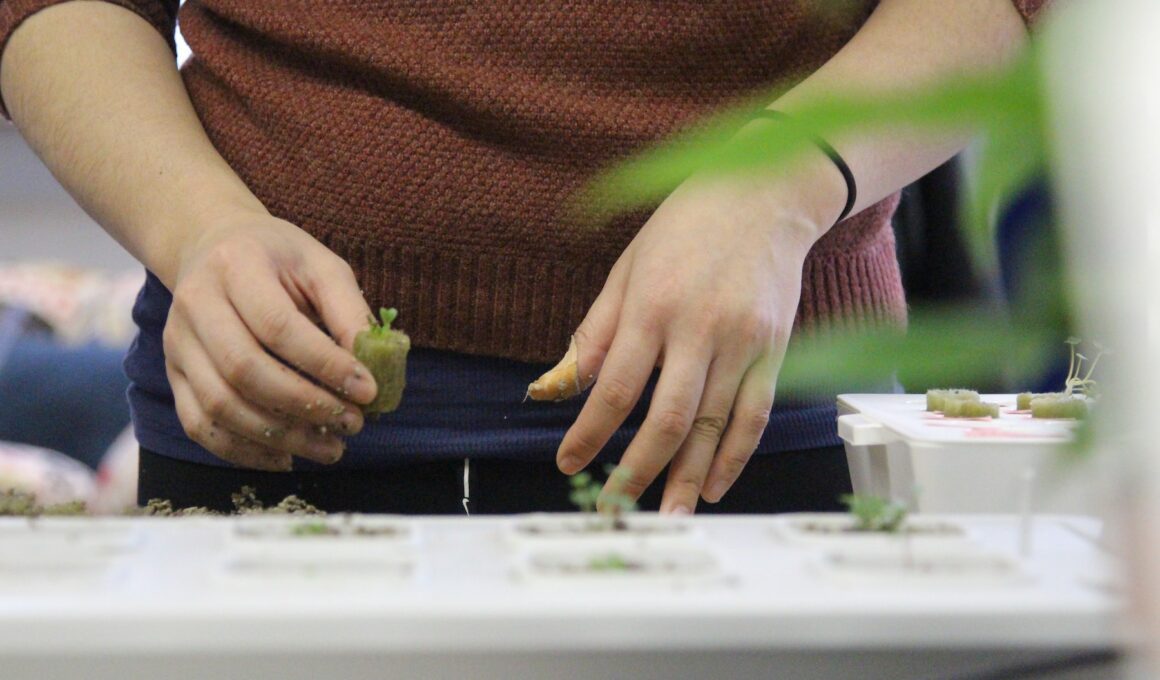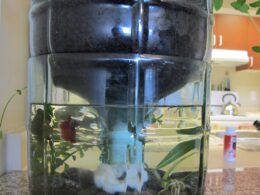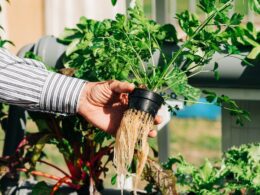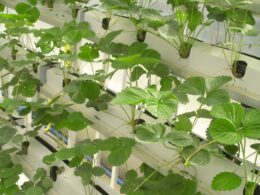Are you a new hydroponic gardener wondering how often you should water your plants in soil? It’s crucial to understand that different plants have different watering needs, and there is no one-size-fits-all approach. Overwatering or underwatering can both lead to negative consequences like root rot, stunted growth, and wilting.
Therefore, it’s essential to determine the watering frequency that suits your plant’s specific needs to ensure optimal growth and health.
In this article, we’ll guide you through the process of understanding your plant’s watering needs, determining the watering frequency, and adjusting it as needed. We’ll also discuss proper watering techniques and how to troubleshoot common watering issues.
By the end of this article, you’ll know how to water your hydroponic plants in soil effectively and keep them thriving. So, let’s dive in!
Understand Your Plant’s Watering Needs
Understand your plant’s watering needs by getting to know its thirst. Adjust your watering accordingly to ensure the growth and well-being of your hydroponic plants in soil. Different plants have varying water requirements, and it’s crucial to know how much water your plant needs in a day.
Factors affecting water absorption include the amount of light, temperature, humidity, and the plant’s size. Plants require more water during the warmer months, so adjust your watering schedule accordingly. The soil should be moist but not waterlogged, as this can lead to root rot and other diseases.
If the leaves turn yellow and wilt, it may be a sign of overwatering or underwatering. To ensure your plant receives adequate hydration, incorporate these tips. Check the moisture level by sticking your finger in the soil. If it feels dry, it’s time to water the plant. Avoid watering the plant on a fixed schedule, as it may result in either overwatering or underwatering.
The best way to ensure your plant receives the proper amount of water is to observe its behavior and adjust your watering accordingly.
Determine the Watering Frequency
To determine the watering frequency of your hydroponic plants, you need to check the moisture level of the soil. You can do this by sticking your finger into the soil to feel if it’s dry or moist.
Another way to check the moisture level is by using a soil moisture meter. Additionally, you can check the weight of the container. If it feels light, it’s time to water your plants.
Lastly, observe your plant’s growth and appearance. If the leaves are drooping or the plant looks dull, it may need more water.
Check the Moisture Level of the Soil
Feeling the moisture level in your soil is crucial to determine watering frequency for hydroponic plants in soil. You can assess the moisture level with different methods, such as sticking your finger into the soil or using a moisture meter. Don’t rely solely on the surface appearance of the soil, as it can be deceiving and not reflect the true moisture content deeper down.
Overwatering is a common concern for hydroponic plant growers. Watering plants too frequently can cause the soil to become waterlogged, leading to root rot and other issues. Checking the moisture level regularly can help you avoid overwatering and ensure proper hydration for your plants. Remember to err on the side of underwatering, as plants can recover from slight dehydration but can be permanently damaged by too much water.
Check the Weight of the Container
By checking the weight of the container, you can easily determine if your plants need watering and ensure they receive the proper amount of hydration. When the soil is dry, it becomes lighter, and the container will feel lighter as well. On the other hand, when the soil is moist, it becomes heavier, and the container will feel heavier too.
This method is simple and effective, and it can prevent dehydration in your hydroponic plants. To ensure your plants receive the proper amount of hydration, here are five tips to keep in mind when tracking the weight of the container:
- Check the weight of the container daily to establish a watering routine.
- Use a consistent container size and type to ensure accurate tracking.
- Water your plants when the container feels light, but not bone dry.
- Avoid overwatering, as it can lead to root rot and other issues.
- Adjust your watering schedule based on the specific needs of your plants and the environment they’re in.
By following these tips and tracking the weight of your container, you can prevent dehydration and ensure your hydroponic plants thrive.
Observe the Plant’s Growth and Appearance
Keep an eye on how your plants are growing and looking, as this can indicate if they’re getting the proper amount of hydration. Plant growth indicators, such as wilting or yellowing leaves, can be a sign that they’re not getting enough water. On the other hand, if the leaves are drooping and the soil is saturated, you may be over-watering your plants.
To ensure your plants are getting the right amount of water, you can also perform soil moisture testing. Insert a finger about an inch deep into the soil, and if it feels dry, it’s time to water your plants. If the soil feels damp or wet, hold off on watering for a few more days.
Remember that different plants have different water needs, so it’s important to research their specific requirements. With a little observation and soil testing, you can easily keep your hydroponic plants in soil healthy and hydrated.
Adjust Watering Frequency as Needed
As you’re watering your hydroponic plants in soil, it’s important to monitor their response to the watering frequency. Keep an eye out for signs of over or under watering, like yellowing leaves or wilting. You should adjust your watering schedule based on any environmental changes that may affect the plant’s water needs, such as temperature or humidity.
Remember to adjust watering frequency as needed.
Monitor the Plant’s Response to Watering
Pay attention to how your plants react to watering to determine the best schedule for their needs. It’s important to understand that different plants have different water requirements, and even individual plants within the same species can have varying needs.
You should observe your plants closely and look for signs of stress, such as drooping leaves or yellowing, to determine if they are getting too much or too little water. Be patient and take the time to understand your plants’ needs.
If you notice that your plants are showing signs of stress, try adjusting your watering schedule accordingly. It may take some trial and error to find the right balance, but paying attention to your plants’ response to watering will ultimately lead to healthier, happier plants.
Remember, it’s better to underwater than overwater, as overwatering can lead to root rot and other issues. By monitoring your plants’ response to watering, you can ensure that they are getting the right amount of water to thrive.
Adjust Based on Environmental Changes
Now that you’re monitoring your hydroponic plants’ response to watering, it’s important to remember that environmental changes can affect their hydration needs.
In order to ensure optimal growth and health, you must adjust your watering schedule accordingly. There are several adjustment techniques you can use based on environmental factors.
For example, if the temperature increases or your plants are receiving more light, they may need to be watered more frequently. On the other hand, if the humidity level rises, you may need to decrease the amount of water you give them to prevent over-saturation.
Keep an eye on your plants’ leaves and soil moisture levels to determine the best course of action. Remember, paying attention to these small details will go a long way in ensuring your hydroponic plants thrive.
How Often Should I Change the Water in my Hydroponic System?
Changing hydroponic water regularly is essential for the overall health and productivity of your system. Ideally, you should replace the water every 1-2 weeks to prevent nutrient imbalances, maintain oxygen levels, and eliminate potential disease-causing pathogens. Consistent water changes ensure optimal conditions for your plants, resulting in vigorous growth and bountiful harvests.
Use Proper Watering Techniques
When it comes to watering your hydroponic plants in soil, using proper techniques is essential. Make sure you always use clean water to avoid introducing harmful bacteria or contaminants to your plants.
Additionally, it’s important to water at the right time of day and to water the soil directly, rather than the leaves.
By following these simple tips, you’ll help ensure your plants stay healthy and thrive in their hydroponic environment.
Use Clean Water
To keep your hydroponic plants healthy and thriving, make sure to use clean water in your system. Using filtered water is a great way to ensure that your plants are getting the nutrients they need without any harmful contaminants. Avoiding tap water is also important, as it can contain high levels of chlorine and other chemicals that can harm your plants.
Here are some tips to help you use clean water in your hydroponic system:
- Use a high-quality water filtration system to remove any impurities from your water source.
- Monitor the pH level of your water regularly to ensure that it’s within the proper range for your plants.
- Clean your water reservoir and any other parts of your system that come into contact with water regularly to prevent the buildup of algae and bacteria.
If you are using tap water, let it sit out for at least 24 hours before using it in your hydroponic system to allow any chlorine to dissipate.
By following these simple steps, you can ensure that your hydroponic plants are getting the clean, healthy water they need to thrive.
Water at the Right Time of Day
Make sure you’re watering your hydroponic plants at the right time of day to maximize their growth and health. Adopting best watering practices and following an optimal watering schedule will help your plants thrive.
Watering your plants during the morning or early evening is the best time as the temperatures are cooler, and the plants can take up the water before the heat of the day causes it to evaporate. Avoid watering your plants during the middle of the day when the sun is at its peak. The heat can cause the water to evaporate quickly, leaving your plants dry and thirsty.
Watering at night is also not recommended as it can lead to the development of fungal diseases. Remember, the right timing of watering is crucial as it can affect the overall health and growth of your hydroponic plants.
Water the Soil, Not the Leaves
You’ll want to focus on nourishing your crops by directing water towards the base of the plants instead of misting the leaves. This will help prevent the growth of harmful bacteria and fungi that thrive in moist environments. Additionally, watering the soil instead of the leaves will ensure that the roots receive the necessary nutrients and moisture to grow healthy and strong.
To effectively manage the moisture levels of your hydroponic plants in soil, it’s important to follow proper watering techniques. Here are some tips to keep in mind:
-
Water your plants in the morning or early afternoon to allow time for the leaves to dry before cooler nighttime temperatures set in.
-
Use a watering can or drip irrigation system to direct the water towards the soil, avoiding the leaves as much as possible.
-
Avoid over-watering your plants as this can lead to root rot and other issues. Only water when the top inch of soil feels dry to the touch.
-
Consider using a moisture meter to help you determine when it’s time to water your plants.
-
Monitor the moisture levels of your plants regularly and adjust your watering schedule as needed to ensure optimal growth and health.
Troubleshoot Watering Issues
If your beloved plants aren’t thriving, it’s time to investigate whether they’re getting the right amount of moisture. Common mistakes in watering hydroponic plants include over watering and under watering.
Over watering can lead to root rot and other fungal diseases, while under watering can cause the plants to wilt and eventually die. To prevent over watering, make sure your hydroponic system has proper drainage and avoid watering your plants on a strict schedule.
Instead, monitor the moisture level of the soil and only water when necessary. You can also use a moisture meter to determine when your plants need watering. If you do accidentally over water your plants, try to improve drainage and reduce watering frequency until the soil dries out.
On the other hand, under watering can be just as detrimental to your plants. To avoid under watering, make sure your hydroponic system has a reliable watering system in place. You can also use mulch or a moisture-retaining soil mix to help prevent soil from drying out too quickly.
If your plants are already showing signs of under watering, try watering them more frequently or misting them with a spray bottle to increase humidity levels. Remember, proper watering is essential to the health of your hydroponic plants.
By avoiding common mistakes and troubleshooting watering issues, you can ensure that your plants thrive and produce a bountiful harvest.
Frequently Asked Questions
Can I use tap water for my hydroponic plants in soil, or should I use filtered or distilled water?
If you want your hydroponic plants in soil to thrive, it’s best to use filtered or distilled water instead of tap water.
While tap water is convenient, it can contain chlorine, fluoride, and other contaminants that can harm your plants.
On the other hand, filtered water is free of impurities, making it a safer choice for your plants.
Using filtered water can also improve the taste and quality of your produce.
So, if you want to ensure the health and safety of your hydroponic plants in soil, it’s best to invest in a water filtration system.
Is it better to water my plants in the morning or at night?
When it comes to watering your hydroponic plants in soil, the timing of your watering can have a big impact on their growth. Many experts recommend watering in the morning, as this allows the plants to absorb the water and nutrients throughout the day, which can promote better growth.
However, others argue that watering at night can be beneficial, as it allows the plants to take in more water without the risk of evaporation. Ultimately, the best watering schedule will depend on a variety of factors, including the specific needs of your plants and the climate in your area.
Additionally, it’s important to consider how watering frequency affects soil-based hydroponic plant growth, as overwatering can lead to root rot and other issues. To ensure the best possible growth for your plants, it’s important to find a balance between watering too often and not often enough, and to monitor your plants closely for signs of stress or dehydration.
How do I know if I am overwatering or underwatering my hydroponic plants in soil?
To ensure the health of your hydroponic plants in soil, it’s important to understand the signs of overwatering and underwatering. Overwatering can lead to root rot and other diseases, while underwatering can stunt growth and cause wilting.
To test soil moisture levels, simply insert your finger about an inch deep into the soil. If it feels dry, it’s time to water. However, if the soil feels consistently wet or waterlogged, you may be overwatering.
Additionally, you can invest in a soil moisture meter to accurately measure moisture levels. By monitoring your plants and adjusting your watering routine accordingly, you’ll be able to keep them thriving and healthy.
Can I use fertilizer to supplement my plants’ water needs, or is water enough?
To ensure your hydroponic plants in soil thrive, it’s important to understand the benefits of supplementing water with fertilizer. Different fertilizer types and their dosing frequency will depend on the specific needs of your plants.
Fertilizer helps provide essential nutrients, such as nitrogen, phosphorus, and potassium, that water alone cannot offer. This can lead to stronger root development, healthier foliage, and improved yield. By properly supplementing your plants with fertilizer, you’ll be able to optimize their growth and achieve a bountiful harvest.
Are there any specific watering techniques that work best for certain types of hydroponic plants in soil?
Proper watering frequency is crucial for the health of your hydroponic plants in soil. Different plants have different nutrient absorption rates, so it’s important to understand the watering needs of each type of plant.
In general, it’s best to water your plants when the top inch of soil feels dry to the touch. Overwatering can lead to root rot and other issues, while underwatering can lead to nutrient deficiencies. Be sure to monitor the moisture level of your soil regularly and adjust your watering schedule as needed.
Remember, healthy plants require a balance of water and nutrients, so it’s important to provide both in the appropriate amounts.
Conclusion
So, now you know how often you should water your hydroponic plants in soil! Remember to always understand your plant’s unique needs and adjust your watering frequency accordingly.
It’s important to use proper watering techniques to ensure that your plants are getting the right amount of water without drowning them. If you do encounter any issues with watering, such as over or under watering, don’t panic. Just take the time to troubleshoot and adjust as needed.
Overall, taking the time to properly water your hydroponic plants in soil will pay off in the long run with healthy, thriving plants. With a little bit of patience and attention to detail, you’ll be able to enjoy a beautiful and abundant harvest. Happy growing!









